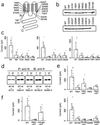The vitelliform macular dystrophy protein defines a new family of chloride channels
- PMID: 11904445
- PMCID: PMC122639
- DOI: 10.1073/pnas.052692999
The vitelliform macular dystrophy protein defines a new family of chloride channels
Abstract
Vitelliform macular dystrophy (VMD/Best disease; MIM*153700) is an early-onset autosomal dominant disorder in which accumulation of lipofuscin-like material within and beneath the retinal pigment epithelium is associated with a progressive loss of central vision. Bestrophin, the protein product of the VMD gene, has four predicted transmembrane domains. There are multiple bestrophin homologues in the human, Drosophila, and Caenorhabditis elegans genomes, but no function has previously been ascribed to these proteins, and they show no detectable homology to other proteins of known function. Using heterologous expression, we show here that human, Drosophila, and C. elegans bestrophins form oligomeric chloride channels, and that human bestrophin is sensitive to intracellular calcium. Each of 15 missense mutations asscociated with VMD greatly reduces or abolishes the membrane current. Four of these mutant bestrophins were coexpressed with the wild type and each dominantly inhibited the wild-type membrane current, consistent with the dominant nature of the disease. These experiments establish the existence of a new chloride channel family and VMD as a channelopathy.
Figures







Similar articles
-
The anion-selective pore of the bestrophins, a family of chloride channels associated with retinal degeneration.J Neurosci. 2006 May 17;26(20):5411-9. doi: 10.1523/JNEUROSCI.5500-05.2006. J Neurosci. 2006. PMID: 16707793 Free PMC article.
-
Molecular physiology of bestrophins: multifunctional membrane proteins linked to best disease and other retinopathies.Physiol Rev. 2008 Apr;88(2):639-72. doi: 10.1152/physrev.00022.2007. Physiol Rev. 2008. PMID: 18391176 Review.
-
Disease-causing mutations associated with four bestrophinopathies exhibit disparate effects on the localization, but not the oligomerization, of Bestrophin-1.Exp Eye Res. 2014 Apr;121:74-85. doi: 10.1016/j.exer.2014.02.006. Epub 2014 Feb 19. Exp Eye Res. 2014. PMID: 24560797 Free PMC article.
-
The mutation spectrum of the bestrophin protein--functional implications.Hum Genet. 1999 May;104(5):383-9. doi: 10.1007/s004390050972. Hum Genet. 1999. PMID: 10394929
-
Bestrophins and retinopathies.Pflugers Arch. 2010 Jul;460(2):559-69. doi: 10.1007/s00424-010-0821-5. Epub 2010 Mar 28. Pflugers Arch. 2010. PMID: 20349192 Free PMC article. Review.
Cited by
-
Two novel mutations in the bestrophin-1 gene and associated clinical observations in patients with best vitelliform macular dystrophy.Mol Med Rep. 2015 Aug;12(2):2584-8. doi: 10.3892/mmr.2015.3711. Epub 2015 Apr 30. Mol Med Rep. 2015. PMID: 25936525 Free PMC article.
-
Detailed analysis of family with autosomal recessive bestrophinopathy associated with new BEST1 mutation.Doc Ophthalmol. 2016 Jun;132(3):233-43. doi: 10.1007/s10633-016-9540-3. Epub 2016 Apr 12. Doc Ophthalmol. 2016. PMID: 27071392 Free PMC article.
-
Microstructural changes of photoreceptor layers detected by ultrahigh-resolution SD-OCT in patients with autosomal recessive bestrophinopathy.Am J Ophthalmol Case Rep. 2022 Sep 24;28:101706. doi: 10.1016/j.ajoc.2022.101706. eCollection 2022 Dec. Am J Ophthalmol Case Rep. 2022. PMID: 36187441 Free PMC article.
-
Expression of anoctamins in retinal pigment epithelium (RPE).Pflugers Arch. 2016 Nov;468(11-12):1921-1929. doi: 10.1007/s00424-016-1898-2. Epub 2016 Nov 7. Pflugers Arch. 2016. PMID: 27822608
-
Diversity of Cl(-) channels.Cell Mol Life Sci. 2006 Jan;63(1):12-24. doi: 10.1007/s00018-005-5336-4. Cell Mol Life Sci. 2006. PMID: 16314923 Free PMC article. Review.
References
-
- Berger J W, Fine S L, Maguire M G. Age-Related Macular Degeneration. St. Louis: Mosby; 1999.
-
- Stone E M, Sheffield V C, Hageman G S. Hum Mol Genet. 2001;10:2285–2292. - PubMed
-
- Weingeist T A, Kobrin J L, Watzke R C. Arch Ophthalmol. 1982;100:1108–1114. - PubMed
-
- Frangieh G T, Green W R, Fine S L. Arch Ophthalmol. 1982;100:1115–1121. - PubMed
-
- Marquardt A, Stohr H, Passmore L A, Kramer F, Rivera A, Weber B H. Hum Mol Genet. 1998;7:1517–1525. - PubMed
Publication types
MeSH terms
Substances
Grants and funding
LinkOut - more resources
Full Text Sources
Other Literature Sources
Medical
Molecular Biology Databases

